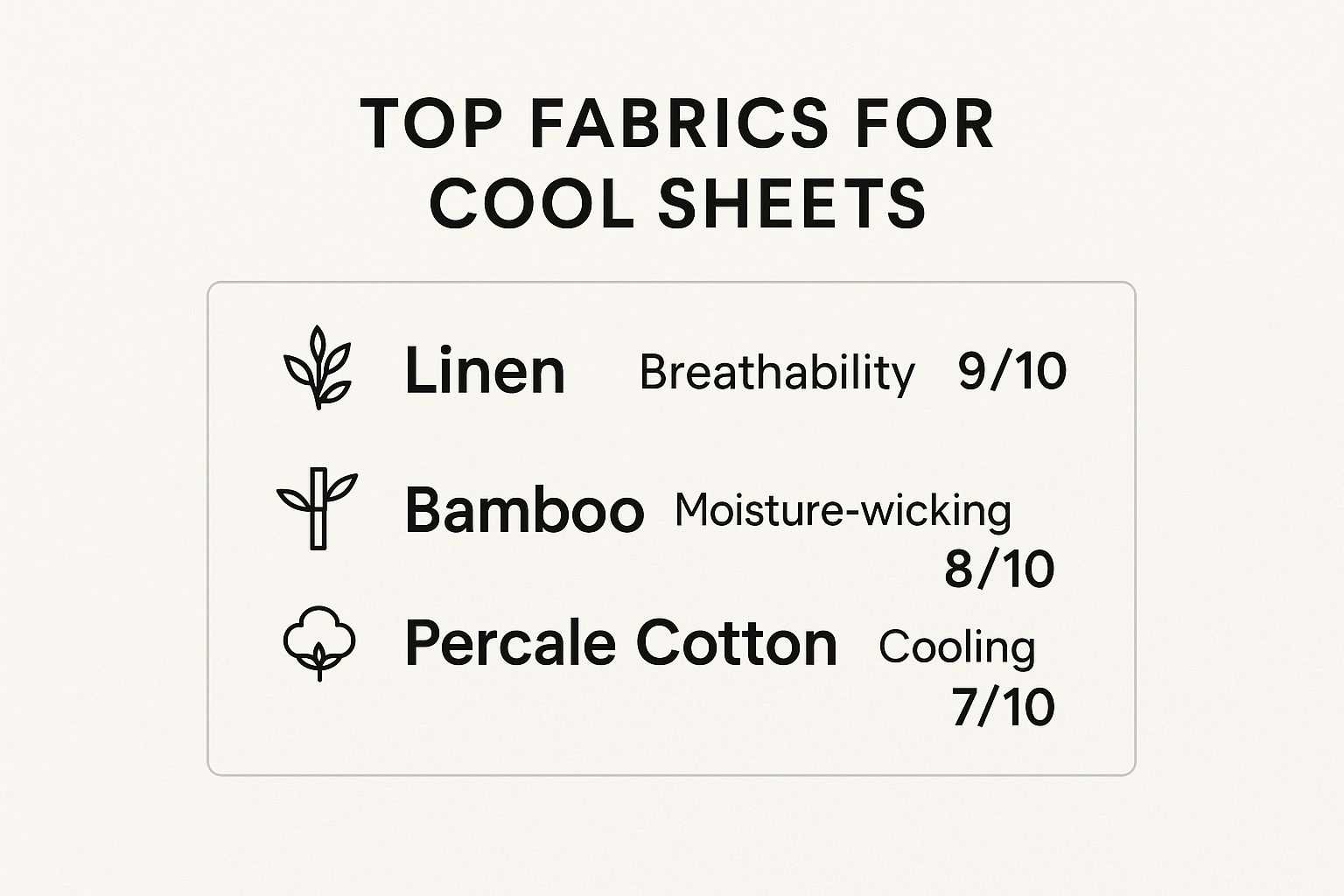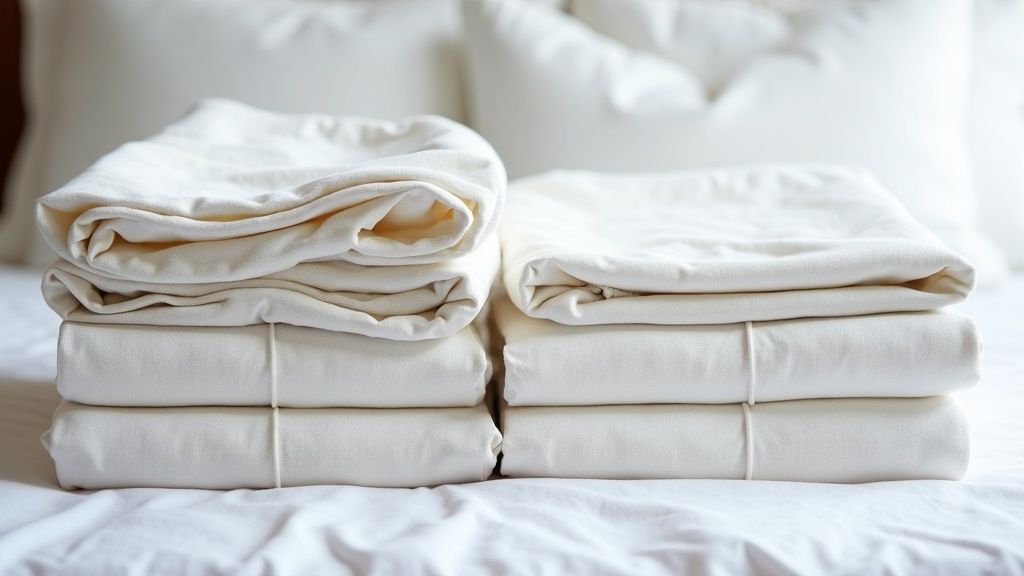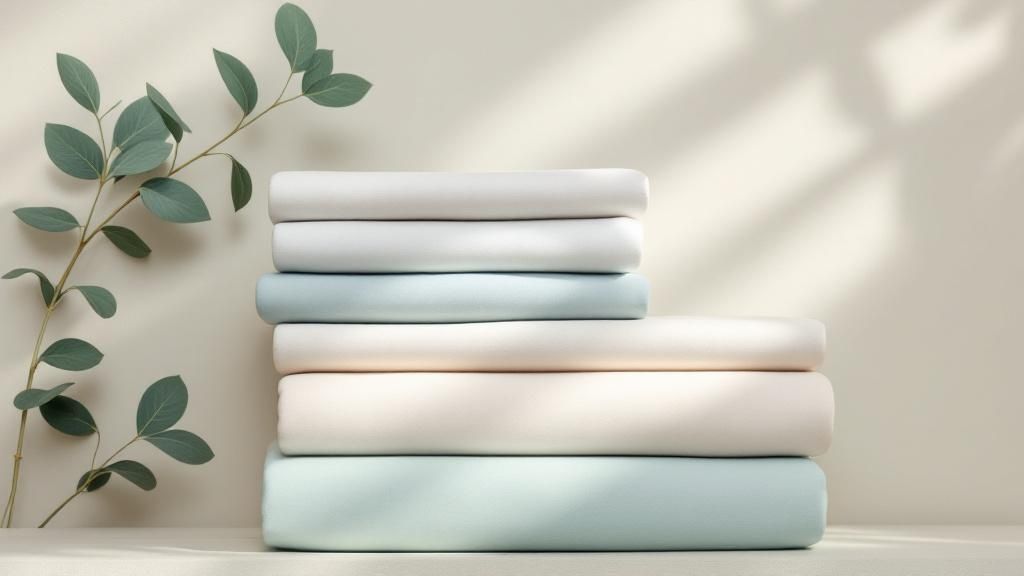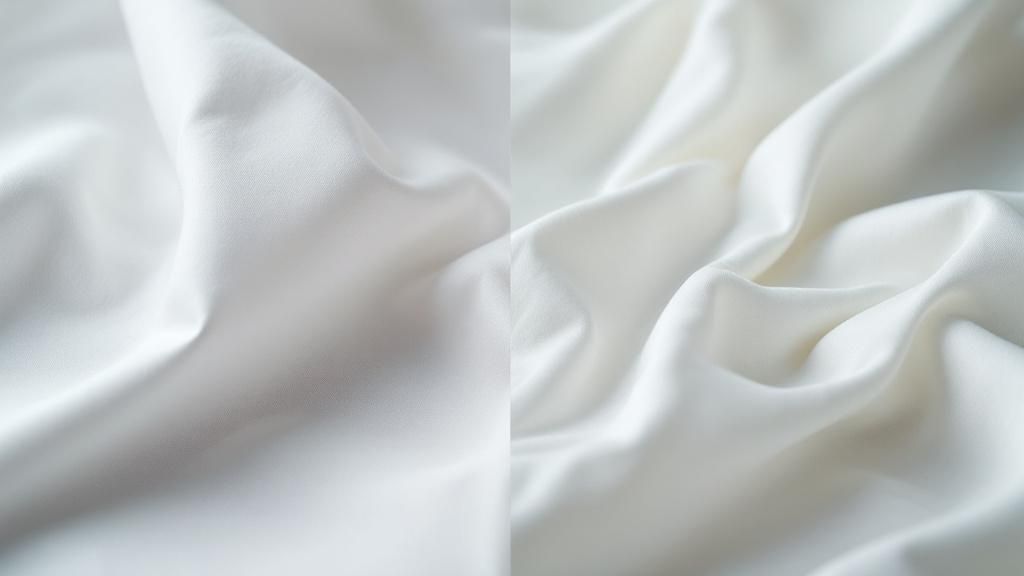If you've ever kicked off the covers in the middle of the night, you know the struggle. Finding the right sheets when you're a hot sleeper isn't just about comfort—it's about getting a decent night's rest. The good news is that the solution often comes down to choosing the right fabric.
When it comes to the best fabric for cool sheets, your best bets are almost always natural, breathable materials. Think linen, Tencel lyocell, and long-staple cotton (especially with a crisp percale weave). These are the fabrics that work with your body, not against it, wicking away moisture and letting air flow freely.
Your Guide to Cooler Nights and Better Sleep
So, what makes a sheet "cooling"? It's not magic, just good old-fashioned science. It boils down to two key factors that separate a sweaty, restless night from a cool, comfortable one.
- Breathability: This is all about airflow. A truly breathable fabric lets your body heat escape instead of trapping it under the covers with you. It’s the difference between feeling fresh and feeling stuffy.
- Moisture-Wicking: This is the fabric’s ability to pull sweat away from your skin and move it to the fabric's surface, where it can evaporate quickly. This process is a game-changer for staying dry and cool all night long.
Top Cooling Sheet Fabrics at a Glance
To make sense of the options, it helps to see how they stack up against each other. Each fabric brings something unique to the table.

As the breakdown shows, linen is an airflow champion, while bamboo is a powerhouse at managing moisture. It's all about what matters most to you.
This table provides a quick comparison of the most popular cooling fabrics to help you identify the best fit for your needs.
| Fabric Type | Key Benefit | Best For |
|---|---|---|
| Linen | Unmatched breathability | Hot, humid climates and those who want an airy feel. |
| Tencel Lyocell | Silky-smooth and moisture-wicking | Sensitive skin and anyone seeking a soft, cool-to-the-touch sheet. |
| Cotton (Percale) | Crisp, lightweight, and durable | Traditionalists who love that classic "cool side of the pillow" feeling. |
| Bamboo Viscose | Excellent moisture absorption | People who sweat a lot and need a fabric that stays dry. |
Ultimately, the right choice depends on your personal preferences for feel and performance.
Many sleep experts have a soft spot for Tencel lyocell, and for good reason. Its unique combination of silky smoothness and impressive temperature regulation is hard to beat. In fact, recent tests ranked a sheet set made from 100% Tencel as a top pick specifically for its consistent breathability and exceptionally soft feel against the skin.
You can dive deeper into the performance of different cooling sheets and see more expert recommendations on SleepFoundation.org.
Comparing the Top Cooling Fabric Contenders
When you're on the hunt for the best fabric for cool sheets, the little details make all the difference. Let's really get into the top contenders that hot sleepers swear by, moving past the marketing hype to look at what really matters: how they feel, how they last, and what they'll cost you.

Cotton Percale: The Crisp Classic
Long-staple cotton, especially in a percale weave, is the classic choice for anyone who loves that crisp, cool, hotel-sheet feel. This fabric is an absolute champion of breathability. Its simple one-over, one-under weave creates a light, airy, matte finish that lets your body heat escape instead of trapping it under the covers.
Think of it as the original performance fabric for your bed. It isn't silky, but it feels incredibly refreshing against your skin. A huge plus is its durability; high-quality cotton percale just gets softer and softer with every wash without falling apart. Price-wise, it's all over the map, from very affordable to pure luxury, depending on the cotton's quality.
Tencel Lyocell: The Silky Innovator
Tencel™ Lyocell is the modern answer to cool, comfortable bedding. This fabric is made from sustainably sourced wood pulp and has a uniquely smooth, silky texture that feels noticeably cool the moment you touch it.
But its real magic is in moisture management. Tencel is roughly 50% more absorbent than cotton, which means it pulls sweat away from your skin before you even realize you're getting warm. This makes it a game-changer for anyone who deals with night sweats.
Tencel’s slick surface and impressive absorbency create a sleep environment that feels consistently dry and cool, making it a top recommendation for those with sensitive skin or who run particularly hot.
While it's a durable fabric, it does need a little TLC—think cold water washes and low-heat drying to keep it feeling luxurious. Tencel sheets usually carry a higher price tag, which reflects their high-performance qualities and more eco-friendly production.
Bamboo Viscose: The Soft and Absorbent Option
Often put in the same category as Tencel, bamboo viscose is another plant-based fiber that's famous for its incredible softness and cooling abilities. It drapes beautifully over the bed and has a gentle, almost buttery feel that people just fall in love with.
Just like Tencel, bamboo is a superstar at wicking moisture away, helping you stay dry all night long. It's also naturally hypoallergenic, which is a massive win for allergy sufferers. The main difference really comes down to a subtle variation in feel; some people find bamboo to be even softer than Tencel. If that sounds appealing, you can dive into the many reasons why bamboo sheets are better to learn more.
Linen: The Breathable Powerhouse
When it comes to pure, unadulterated airflow, linen is king. Made from the flax plant, its naturally hollow fibers allow for maximum air circulation, making it an unbeatable choice for anyone living in a hot, humid climate.
At first, new linen can feel a bit coarse, but it transforms over time, softening dramatically to develop a perfectly relaxed, lived-in texture. Its open weave means it never clings to your skin on a sticky night. Durability is another one of its superpowers, as linen is one of the strongest natural fibers out there. The trade-offs? It wrinkles easily and comes at a premium price, but for unrivaled breathability, nothing else even comes close.
Why Is Everyone Suddenly Talking About Cooling Sheets?
It feels like just yesterday, the only real choice in bed sheets was cotton or flannel. Now, it seems like everyone is on the hunt for bedding that keeps them cool. This isn't just a fleeting trend; it’s a major shift in how we think about sleep, and a few key things are driving it.

For one, rising global temperatures are making it harder to get a comfortable night's sleep. Those old, heavy sheets that used to feel cozy now often feel like a trap, holding in heat and making warm nights unbearable. People are actively looking for a solution.
At the same time, we've all become much more aware of how crucial good sleep is for our overall health. We're tracking our sleep, optimizing our routines, and we’re no longer willing to put up with tossing and turning in a pool of sweat. Investing in better sleep is investing in better health, and that starts with the right bedding.
A Revolution in Cooling Fabric Technology
This massive consumer demand has really lit a fire under the textile industry. We're seeing some incredible innovation in fabrics designed not just to feel cool to the touch, but to actively manage your body temperature all night long.
It goes way beyond a simple loose weave. Modern cooling textiles are engineered for performance.
- Next-Level Moisture Wicking: Materials like bamboo viscose and Tencel are amazing at pulling moisture away from your skin, so you stay dry even if you sweat.
- Engineered for Airflow: Today’s fabrics are designed with breathability in mind, creating micro-gaps in the weave that let body heat escape instead of building up.
This isn't a small niche, either. The market for cooling fabrics has exploded, valued at USD 1.85 billion in 2024 and on track to hit USD 3.62 billion by 2033. That’s some serious growth, and it shows this is a permanent change in consumer priorities.
Simply put, people are tired of being hot and tired. The demand for a real solution is driving this market, and the technology is finally here to deliver it.
Fabrics like bamboo have shot to the top of the list for good reason. They offer that perfect combination of silky softness, incredible breathability, and a sustainable footprint. If you're a hot sleeper who also cares about making eco-friendly choices, you'll want to check out our detailed look at bamboo sheets as a cool and eco-friendly choice for hot sleepers. It helps explain why these materials have become so popular and what makes them a smart investment for better sleep.
How Weave and Thread Count Affect Breathability
Picking the right material is a great start, but the search for the best fabric for cool sheets doesn’t stop there. How the individual fibers are woven together is just as important—it can be the difference between a sheet that feels light and airy or one that feels dense and stuffy.
I like to think of it this way: the fabric is the main ingredient, but the weave is the recipe that determines the final dish.
The Big Two: Percale vs. Sateen
You'll almost always run into two main players in the bedding world: percale and sateen. A percale weave is constructed with a simple one-thread-over, one-thread-under pattern. This classic grid creates a ton of tiny spaces for air to move, resulting in a crisp, matte-finish sheet that feels refreshingly cool to the touch. It's a go-to for hot sleepers.
On the other hand, a sateen weave follows a different pattern, typically one-thread-under and three-or-four-threads-over. This technique exposes more of the thread’s surface, which is what gives sateen its signature silky feel and lustrous sheen. But that tighter structure comes at a cost—it traps more heat, making it a less-than-ideal choice if you tend to overheat at night.

Decoding the Myth of High Thread Count
Now, let's tackle one of the most common myths in the bedding industry: thread count. We've all been led to believe that a higher number means better quality, but when it comes to sleeping cool, that’s just not the case.
Thread count simply measures the number of threads woven into one square inch of fabric. When you see a super high number like 800 or 1,000, it means those threads are crammed together incredibly tightly. This dense fabric leaves virtually no room for air to circulate, creating a barrier that traps your body heat.
For the best breathability, the sweet spot for thread count is usually between 200 and 400. This range strikes the perfect balance, giving you sheets that are soft and durable without smothering you.
So, don't get fooled by a big number on the package. Pay more attention to the quality of the fiber and the type of weave. From experience, a 300-thread-count long-staple cotton percale sheet will almost always keep you cooler than a 1,000-thread-count sateen sheet.
Want to see how all these details come together? Dive deeper in our guide to the https://bamtekhome.com/blogs/best-breathable-bed-sheets for more expert tips.
Here’s the rewritten section, designed to sound completely human-written and natural.
What People Want in Cooling Sheets Around the World
The hunt for the perfect cooling sheets is a global one, but what people look for really depends on where they live. These regional differences are fascinating, and they can help you understand what's driving the market and find sheets that actually fit what you care about.
Different Priorities, Different Markets
In North America, for example, performance is king. Shoppers there tend to look for practical features—they want sheets that feel cool, sure, but they also have to be durable and easy to wash. It’s all about a mix of comfort and convenience.
Jump over to Europe, and the conversation shifts heavily toward sustainability. You’ll see shoppers actively looking for certifications like OEKO-TEX or GOTS. For them, knowing the sheets are organic and made ethically is just as important as how they feel. This focus on eco-friendly production really shapes what's popular.
What’s Driving the Demand?
These preferences tell a bigger story about what consumers in each region value.
- In the Americas, there’s a growing obsession with sleep hygiene, and people have the income to invest in it. This has fueled a huge demand for both high-end and eco-certified bedding.
- Meanwhile, in the Middle East and North Africa, a lot of the demand comes from the luxury hotel industry. They’re constantly looking for the latest in temperature-regulating technology to give their guests an incredible sleep experience.
You can dig deeper into these global bedding market trends to see how things are shifting.
At the end of the day, these global trends impact the cooling sheets you see on the shelf. Whether a brand is shouting about its high-tech fibers or its sustainable sourcing, understanding where they're coming from helps you cut through the marketing noise and choose your bedding with confidence.
Still Have a Few Questions About Cool Sheets?
When you start digging into the world of cooling bedding, a few final questions always seem to pop up. Let's clear the air and make sure you have all the info you need to find sheets you'll absolutely love sleeping in. Here are some of the things people often ask.
Is Tencel Cooler Than Cotton?
This is a classic showdown, and honestly, both are great options—they just work a little differently.
Tencel has this incredibly silky, smooth feel and is a superstar when it comes to absorbency. It's actually more absorbent than cotton, which means it excels at pulling sweat away from your skin. If you're a really hot sleeper prone to night sweats, Tencel is probably your best bet.
On the other hand, you can't beat the classic, crisp feel of a high-quality cotton percale. It's exceptionally breathable and gives you that iconic "cool side of the pillow" sensation all over. If you value that light, airy feeling over pure moisture-wicking, percale cotton is the way to go. It really boils down to personal preference on feel and function.
Does a Higher Thread Count Mean Cooler Sheets?
It's a common myth that higher is better, but for cooling, that’s not the case. A super high thread count—anything over 500—usually means the threads are packed together so tightly that air can't move through. You end up with a dense fabric that traps your body heat.
For sheets that actually breathe, you want to aim for a more moderate thread count, somewhere in the 200 to 400 range. What's far more important is the quality of the fiber itself and the type of weave, like percale, which is specifically designed for airflow. Don't get caught up in the numbers game.
Here's a pro tip that makes a huge difference: skip the fabric softener and dryer sheets. They coat the fibers with a waxy residue that clogs the fabric's natural pores, which kills both breathability and moisture-wicking power.
To keep your sheets working their best, always wash them in cool or warm water on a gentle cycle. Tumble dry on a low setting, or even better, line dry them if you can. This will help protect the fibers and maintain their cooling properties for the long haul.
Ready to finally get a cooler, more comfortable night's sleep? Discover the luxurious feel of Bamtek's 100% organic bamboo viscose bedding. Experience the difference an eco-friendly, thermoregulating fabric can make. Explore our collection at Bamtek Home.










